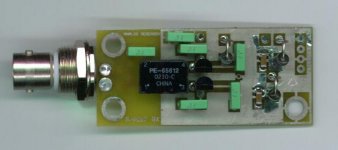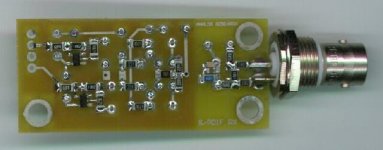I'm using relays for I/O switching in the DAC. I'm concerned of whether that may introduce problems. My internal wiring for the digital signal is also coax, to try to maintan the characteristic impedance as much as possible, and even the jacks and cable plugs are 75 Ohm. However, this is clearly not the case for the relays. My question is how much of a problem that is, when for a couple of inches the signal path is not with 75 Ohm impedance. Also, the relays are latching, so no current flows through the coil except momentarily when switching, and they are sealed, so contacs should last. But I'm worried about reflections and so on.
Z-matching for aes/spdif
digital audio signals (spdif / aes-3) are not actually very sensitive to impedance matching. You shouldn't go too far out of course, but relatively minor impedance mismatch will result in 'ripples' at the top and bottom of the waveform but with minimal influence on the signal timing as it passes through the logic transition level.
Video signals are sensitive to this hence the emphasis on Z-matching there.
Nothing is ever perfect of course and i don't know what signal path length you are looking at but if I were you I'd try it then evaluate for real. I reckon cable capacitance / program induced jitter is much more of a problem.
regards
digital audio signals (spdif / aes-3) are not actually very sensitive to impedance matching. You shouldn't go too far out of course, but relatively minor impedance mismatch will result in 'ripples' at the top and bottom of the waveform but with minimal influence on the signal timing as it passes through the logic transition level.
Video signals are sensitive to this hence the emphasis on Z-matching there.
Nothing is ever perfect of course and i don't know what signal path length you are looking at but if I were you I'd try it then evaluate for real. I reckon cable capacitance / program induced jitter is much more of a problem.
regards
Prune,
I would use solid state switching. Convert the coax to TTL and use a multiplexor like OliFilth said. It would be much better, with less loss, noise and transient replay "pops".
I'm jealous of you're DAC working. Well, now that I have everything but the soldering station (which comes in a few days) I'll be able to do a much better soldering job. After all, I'm certified to operate Pace equipment, so it'll be easy.
Well, now that I have everything but the soldering station (which comes in a few days) I'll be able to do a much better soldering job. After all, I'm certified to operate Pace equipment, so it'll be easy.
I would use solid state switching. Convert the coax to TTL and use a multiplexor like OliFilth said. It would be much better, with less loss, noise and transient replay "pops".
I'm jealous of you're DAC working.
Like the last two posts say it's probably better to use logic gates/switching. I don't know your particular application but if you can do the switching at logic level rather than the spdif signal itself then it becomes much simpler and you can terminate the lines correctly. If you need to switch the spdif/iec950 itself then there are probably devices designed for video signal switching that will do the job - maybe look at Elantec semiconductors ?
Having said that there can be cases where relays might be preferable depending on power supply voltages available etc etc...
Having said that there can be cases where relays might be preferable depending on power supply voltages available etc etc...
Believe it or not.........
I once used a relay to switch SPDIF siganls......and a cheap one from NAIS worked better than the expensive one designed for RF.
You can do it, but it does take some work to keep reflections down. CMOS solutions can also contribute to reflections, so it is not a foolproof solution.
Jocko
I once used a relay to switch SPDIF siganls......and a cheap one from NAIS worked better than the expensive one designed for RF.
You can do it, but it does take some work to keep reflections down. CMOS solutions can also contribute to reflections, so it is not a foolproof solution.
Jocko
what i'm suggesting is a properly terminated 75ohm receiver interface which produces a logic level which can then be switched/distributed locally without influence on the 75ohm line.
See Crystal Semiconductor / AKM datasheets / application notes for examples also the 'Digital Audio Interface' (or something like that) book by John Watkins (or similar - this from memory) or if you want a big read on the whole digital audio field - 'The Art of Digital Audio'.
Not that it has to be complicated.
What sort of problem symptoms did you get with the rf relay ?
You can get problems if there is not enough current for the contact design.
See Crystal Semiconductor / AKM datasheets / application notes for examples also the 'Digital Audio Interface' (or something like that) book by John Watkins (or similar - this from memory) or if you want a big read on the whole digital audio field - 'The Art of Digital Audio'.
Not that it has to be complicated.
What sort of problem symptoms did you get with the rf relay ?
You can get problems if there is not enough current for the contact design.
The problem is that the nice pulse transformers I use for termination on the DAC side aren't cheap, and terminating each of the inputs with them before feeding into a multiplexer is not something I can afford. That's why I only used one transformer after relays. Also someone pointed out where to buy 50 ohm coaxial relays, but S/PDIF is 75 ohm. On top of this, my manual and remote control system is set up for latching relays, and I've never found any 75 ohm latching relays.
I wonder if I just leave the non-coax relays I have in, would there be any improvement if I were to shield them with grounded foil, or would that make it even worse?
I wonder if I just leave the non-coax relays I have in, would there be any improvement if I were to shield them with grounded foil, or would that make it even worse?
I used relays for the same reason.
Foil over them??? I don't see any reason for it.
There are so many things that cause reflections, that you might have more than you realise already. I have seen some DACs where they run several inches of twisted pair wire into some big caps (physically, not electrically), and then some PCB traces....and finally into the RX chip.
(And a chip that I hate, but we won't go into that..........)
But speaking of which.....it causes a boatload of relections all by itself.
Bottome line......
You would be amazed by how much crap you can get away with, and still have it work. The jitter may be off the scale, but it will work.
You probably have around 1 nSec jitter in your setup to begin with, even with everything working at 100%. So you add another nanosecond or so.......
Getting that extra amount out takes lots of work, and fancy test equipment. Trust me.
Jocko
Foil over them??? I don't see any reason for it.
There are so many things that cause reflections, that you might have more than you realise already. I have seen some DACs where they run several inches of twisted pair wire into some big caps (physically, not electrically), and then some PCB traces....and finally into the RX chip.
(And a chip that I hate, but we won't go into that..........)
But speaking of which.....it causes a boatload of relections all by itself.
Bottome line......
You would be amazed by how much crap you can get away with, and still have it work. The jitter may be off the scale, but it will work.
You probably have around 1 nSec jitter in your setup to begin with, even with everything working at 100%. So you add another nanosecond or so.......
Getting that extra amount out takes lots of work, and fancy test equipment. Trust me.
Jocko
Re: Groupbuy
Transformer I would guess. I think I have this schematic on a napkin somewhere...
Elso Kwak said:Edit: what is that black squarish thingy?
Transformer I would guess. I think I have this schematic on a napkin somewhere...
Re: Sure you are still interested???
Jocko
I'll take 4; pl email.
Fred
-------------------------------------------------------------------------------Jocko Homo said:Any and all profits go the the Jocko Homo Avoid Bankruptcy Pizza Fund.
Here is the back view.......big enough to see, but too small for the "vacuum cleaners" to get the component values.
Heh-heh.
Jocko
Jocko
I'll take 4; pl email.
Fred
- Status
- This old topic is closed. If you want to reopen this topic, contact a moderator using the "Report Post" button.
- Home
- Source & Line
- Digital Source
- Relays in digital signal path

